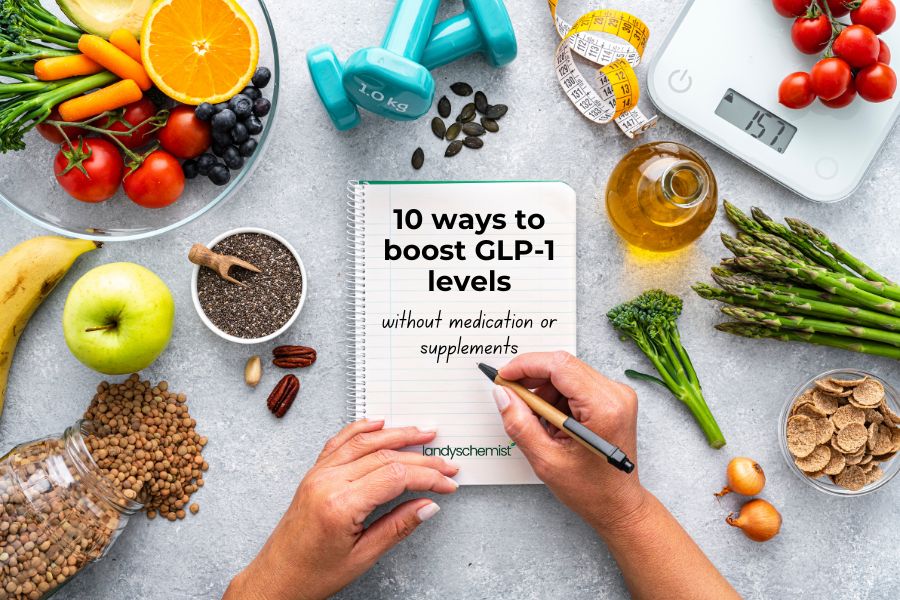
10 Ways To Naturally Increase GLP-1 Levels

Glucagon-Like Peptide-1 (GLP-1) is a hormone produced in the gut that plays a critical role in blood sugar regulation, appetite control, and overall metabolic health. It supports blood sugar balance by stimulating insulin release and reducing glucagon, a hormone that raises blood sugar levels.
GLP-1 also slows digestion, helping you feel fuller for longer—an essential factor for weight management.
Foods high in fibre, protein, and healthy fats, such as whole grains, vegetables, and lean proteins, can naturally stimulate GLP-1 release, making these dietary adjustments a valuable way to boost metabolic health and support blood sugar control.
Natural GLP-1 activators like berberine, curcumin, probiotics, and green tea extract offer supportive benefits for blood sugar control and metabolism. To learn more about these supplements and how they work, check out our blog on the best natural GLP-1 boosting supplements.
What factors contribute to low GLP-1 levels?
Various factors can impact GLP-1 levels in the body, influencing how effectively this hormone supports blood sugar regulation, appetite control, and metabolic health. Understanding these factors can help you make more informed choices to naturally support and optimise GLP-1 production:
- Metabolic Disorders: Type 2 diabetes, obesity, metabolic syndrome, and insulin resistance can reduce GLP-1 secretion and responsiveness, impacting blood sugar and appetite control.
- Liver and Pancreatic Health: Liver diseases (e.g., NAFLD) and pancreatic disorders (e.g., pancreatitis) may impair GLP-1 metabolism and insulin regulation.
- Gastrointestinal Conditions: Disorders like IBS and IBD can alter gut function, affecting GLP-1 production.
- Diet and Lifestyle: High-fat diets, smoking, and chronic inflammation can decrease GLP-1 levels and disrupt metabolic balance.
- Ageing: Natural GLP-1 production tends to decline with age, making blood sugar and appetite regulation more challenging over time.
10 ways to increase GLP-1 naturally
While these natural methods may not produce the same dramatic results as GLP-1 agonist medications, they offer a sustainable and gentle way to support GLP-1 levels. For many, these lifestyle changes can help with managing blood sugar, regulating appetite, and promoting gradual weight loss. Combined with other healthy habits, they contribute to a more balanced and long-term approach to metabolic health.
1.High-Fibre Foods
Fibre-rich foods, especially those high in soluble fibre, help stimulate GLP-1 secretion by slowing down digestion and supporting feelings of fullness. Adding foods like oats, chia seeds, legumes, apples, and vegetables to your diet can encourage natural GLP-1 release while also supporting gut health, which is crucial for metabolic balance.
2. Eat More Protein
Protein can impact GLP-1 levels by stimulating GLP-1 secretion in the gut. Including quality protein sources like eggs, lean meats, fish, legumes, and dairy at each meal can help regulate appetite and support blood sugar stability
3. Fermented Foods
A balanced gut microbiome is essential for GLP-1 production. Probiotic-rich fermented foods like yogurt, kefir, kimchi, and sauerkraut not only support gut health but also influence the secretion of gut hormones like GLP-1. Maintaining a healthy gut through these foods can naturally promote hormone function, benefiting metabolism and blood sugar regulation.
4. Try Intermittent Fasting
Intermittent fasting, which involves cycling between periods of eating and fasting, has been shown to support GLP-1 levels. Fasting periods allow your body to naturally regulate hunger hormones, including GLP-1. Popular methods like the 16:8 or 5:2 fasting approaches may help improve insulin sensitivity and aid in appetite control.
5. Regular Exercise
Exercise, particularly aerobic activities like walking, cycling, or swimming, has been associated with an increase in GLP-1 levels. Exercise enhances insulin sensitivity, supports metabolic health, and stimulates the secretion of GLP-1. Aim for at least 150 minutes of moderate aerobic activity per week, or find enjoyable ways to stay active every day.
6. Quality Sleep
Good sleep is essential for hormone regulation, including GLP-1. Studies show that poor sleep can lead to hormonal imbalances, which affect appetite control and insulin sensitivity. Aim for 7–8 hours of quality sleep each night to support GLP-1 secretion and maintain healthy blood sugar levels.If you’re struggling with sleep, tart cherry juice may improve sleep cycles.
7. Limit Processed and Sugary Foods
Processed and sugary foods can disrupt gut health and interfere with GLP-1 secretion. By limiting high-sugar, low-fibre foods and opting for whole, nutrient-dense options, you’ll support both your gut and metabolic health, encouraging better GLP-1 production and appetite control.#
8. Hydration
Proper hydration is essential for overall health and can significantly influence GLP-1 levels. Dehydration can reduce GLP-1 secretion and increase hunger. To ensure adequate hydration, aim to drink at least 8 cups (64 ounces) of water daily and incorporate hydrating foods like fruits and vegetables into your diet.
9. Healthy Fats
Incorporating healthy fats into your diet, such as avocados, nuts, seeds, and olive oil, can enhance GLP-1 secretion. Research has shown that olive oil, in particular, promotes higher concentrations of GLP-1, highlighting the potential relationship between healthy fats and factors related to diabetes management.
10. Manage Stress Levels
Chronic stress can reduce GLP-1 effectiveness due to elevated cortisol levels. Practising stress management techniques like meditation, deep breathing, or yoga can help maintain balanced GLP-1 levels.
Will These Diet and Lifestyle Changes Make a Big Enough Difference on Their Own?
For someone with type 2 diabetes or significant metabolic challenges, these lifestyle changes can certainly help but may not provide results as strong or fast as GLP-1 agonist medications or supplements. While increasing fibre, protein, exercise, and managing stress can support blood sugar control and improve GLP-1 levels, they often work more gradually and may not be enough on their own for those with serious blood sugar issues.
In reality, most individuals with type 2 diabetes benefit from a combination approach, where lifestyle changes support the effectiveness of medications or supplements. Medications like GLP-1 agonists can provide essential, targeted control that lifestyle alone may not achieve. However, adopting these habits is still highly beneficial, as it can enhance medication effectiveness, support long-term health, and potentially reduce dependency on medications over time. For those who may want to avoid GLP-1 activating medications, you can explore natural supplement alternatives.
Summary
Increasing GLP-1 levels through natural approaches is about supporting your body’s metabolic health in a sustainable, everyday way. While medications may be necessary for some, making conscious choices around diet, activity, and stress can positively influence GLP-1 levels and overall well-being. These lifestyle habits work to stabilise blood sugar, promote fullness, and manage weight - all important factors for long-term health.
References:
- https://pmc.ncbi.nlm.nih.gov/articles/PMC10648557/
- https://pmc.ncbi.nlm.nih.gov/articles/PMC8634310/
- https://pmc.ncbi.nlm.nih.gov/articles/PMC10790698/
- https://clindiabetesendo.biomedcentral.com/articles/10.1186/s40842-020-00116-1
- https://www.frontiersin.org/journals/physiology/articles/10.3389/fphys.2022.809669/full
- https://www.mdpi.com/2673-4540/3/4/42
- https://pubmed.ncbi.nlm.nih.gov/12600850/
- https://pmc.ncbi.nlm.nih.gov/articles/PMC3778098/
Disclaimer: This article is for informational purposes only and is not a substitute for medical advice. Consult your doctor or healthcare provider before starting any supplements, treatments, or remedies. Ensure a varied and balanced diet and a healthy lifestyle before considering supplements. Supplements should not replace a balanced diet.




